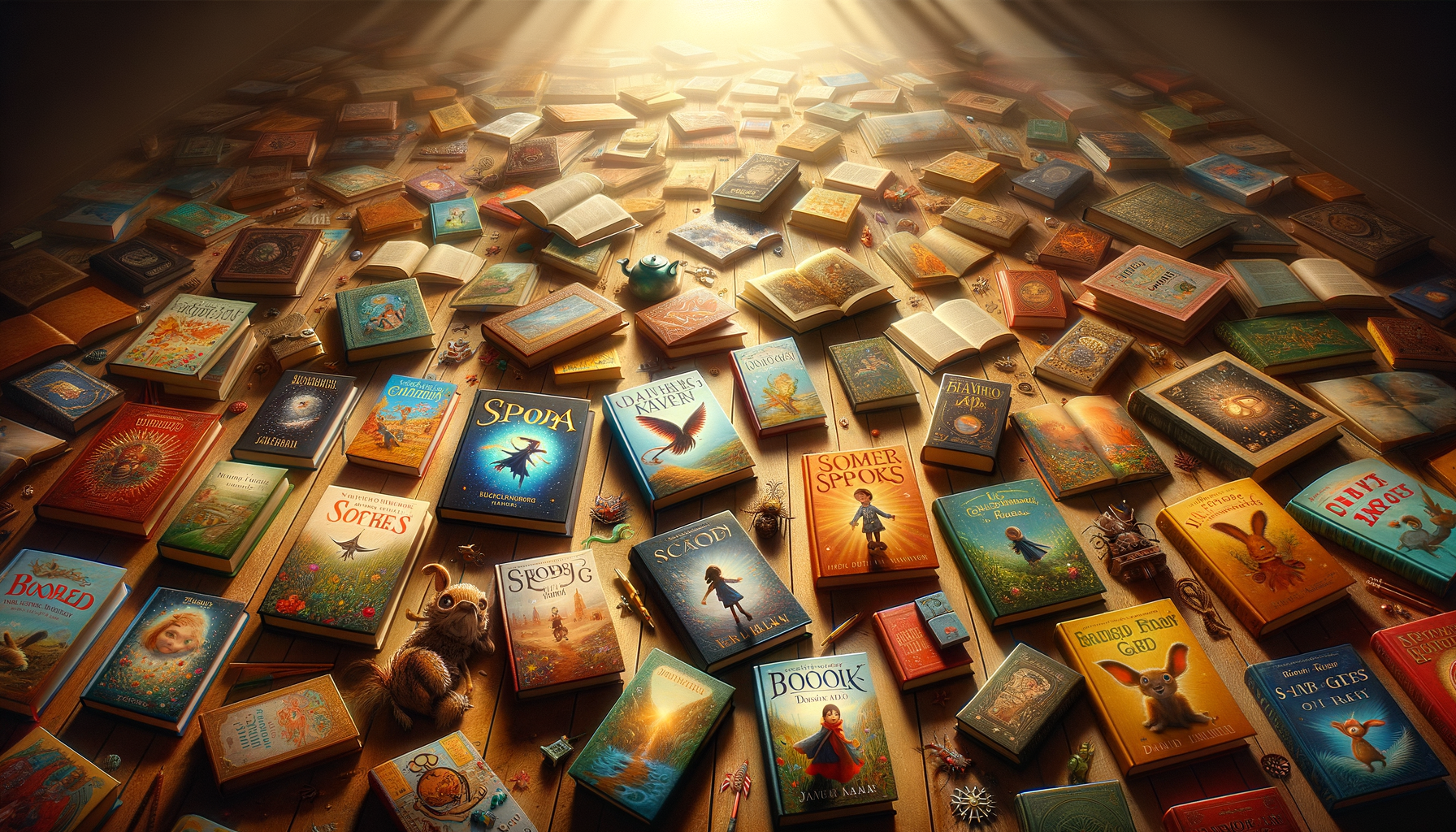The Magical World of Children’s Literature
Children’s literature holds a special place in the world of books, offering young readers a gateway to imagination, learning, and growth. The genre encompasses a wide range of themes and styles, from whimsical fairy tales to educational non-fiction. One of the key aspects of children’s books is their ability to spark curiosity and foster a love for reading from an early age. This section delves into the enchanting world of children’s literature, exploring how these books shape young minds.
Children’s literature is not only about entertainment; it plays a crucial role in cognitive and emotional development. Books for kids often introduce new concepts, enhance vocabulary, and improve comprehension skills. Moreover, they help children understand complex emotions and social situations through relatable characters and stories. For instance, picture books use vivid illustrations and simple narratives to convey messages about friendship, empathy, and resilience.
As children grow, their reading preferences evolve. Early readers may enjoy books with repetitive text and colorful illustrations, while older children might gravitate towards chapter books with more intricate plots. Popular series often capture the imagination of young readers, encouraging them to follow the adventures of beloved characters across multiple books. This sustained engagement with a series can significantly enhance a child’s reading fluency and comprehension.
In summary, children’s literature is a vital component of early education, providing a foundation for lifelong learning. By offering diverse stories and characters, these books not only entertain but also educate, instilling values and skills that children carry into adulthood.
Choosing the Right Books for Different Ages
Selecting the appropriate books for children can be a daunting task, given the vast array of options available. However, understanding the developmental stages of young readers can simplify this process. This section provides guidance on choosing books that align with the age and interests of children, ensuring an engaging and enriching reading experience.
For infants and toddlers, board books with simple text and bright illustrations are ideal. These books often feature repetitive phrases and rhymes, which are crucial for language development. As children transition to preschool, picture books become more prominent. These books often contain more complex narratives and illustrations that encourage storytelling and imagination.
Elementary-aged children benefit from a mix of picture books and early chapter books. At this stage, children are developing reading fluency and comprehension skills. Books that challenge their vocabulary while maintaining engaging storylines are highly recommended. Series books are particularly popular among this age group, as they provide familiar characters and settings that encourage continued reading.
As children enter middle school, they are ready for more complex narratives and themes. Young adult (YA) literature often features protagonists dealing with issues relevant to pre-teens and teenagers, such as identity, friendship, and family dynamics. These books not only entertain but also provide valuable insights into the challenges of growing up.
Ultimately, the key to selecting the right books is to consider the child’s interests and reading level. Encouraging children to explore different genres and authors can broaden their literary horizons and foster a lifelong love for reading.
The Impact of Books on Child Development
Books play a pivotal role in the developmental journey of children, influencing various aspects of their growth. From enhancing cognitive abilities to shaping social skills, the impact of books on child development is profound and multifaceted. This section examines how reading contributes to the holistic development of children.
One of the primary benefits of reading is the enhancement of language skills. Exposure to a rich vocabulary through books helps children develop better communication skills. As they encounter new words and phrases, children learn to express themselves more effectively. Furthermore, reading improves concentration and focus, as children need to pay attention to the storyline and remember details to understand the plot.
Books also play a crucial role in emotional development. Stories often mirror real-life situations, allowing children to see the world through different perspectives. This exposure helps them develop empathy and understanding for others. Books that address emotions and feelings provide children with tools to navigate their own emotional experiences.
In addition to cognitive and emotional benefits, books also contribute to social development. Reading about diverse characters and cultures broadens a child’s worldview, promoting inclusivity and acceptance. Books that depict teamwork and collaboration teach children the importance of working together and resolving conflicts peacefully.
In conclusion, books are an invaluable resource for child development, offering benefits that extend beyond academic learning. By encouraging children to read regularly, parents and educators can support their growth into well-rounded individuals.
Popular Genres in Children’s Books
Children’s literature is rich with a variety of genres, each offering unique experiences and learning opportunities. Understanding these genres can help parents and educators select books that cater to the diverse interests of young readers. This section explores some of the most popular genres in children’s books and their appeal to different age groups.
Fantasy is a beloved genre among children, transporting them to magical worlds filled with adventure and wonder. Books in this genre often feature mythical creatures, enchanted lands, and heroic quests, captivating the imagination of young readers. Fantasy stories encourage creativity and allow children to explore the boundaries of their imagination.
Adventure books are another popular choice, offering thrilling narratives that keep readers on the edge of their seats. These stories often involve quests, mysteries, and explorations, providing excitement and suspense. Adventure books are particularly appealing to children who enjoy action-packed plots and dynamic characters.
For children interested in real-world topics, non-fiction books provide factual information on a wide range of subjects. From biographies to science and history, non-fiction books cater to curious minds eager to learn about the world around them. These books often include illustrations, photographs, and diagrams to enhance understanding and engagement.
Humor is a genre that resonates with readers of all ages, and children’s books are no exception. Funny stories and characters bring joy and laughter, making reading an enjoyable experience. Humor books often use playful language and situations to entertain and engage young readers, fostering a positive attitude towards reading.
By exploring different genres, children can discover their preferences and develop a diverse reading habit. Encouraging them to read across genres not only enhances their literary skills but also broadens their understanding of various themes and ideas.
Encouraging a Lifelong Love for Reading
Instilling a passion for reading in children is one of the greatest gifts parents and educators can offer. A lifelong love for reading opens doors to knowledge, creativity, and personal growth. This section provides strategies for encouraging children to embrace reading as a cherished activity.
Creating a reading-friendly environment at home is a fundamental step. A dedicated reading space with comfortable seating and easy access to a variety of books can inspire children to pick up a book. Regular visits to libraries and bookstores also expose children to a wide array of reading materials, allowing them to explore different genres and authors.
Role modeling is another effective way to encourage reading. When children see adults reading and discussing books, they are more likely to view reading as a valuable and enjoyable activity. Engaging in family reading sessions or book discussions can further strengthen this habit.
Incorporating technology can also enhance the reading experience. Audiobooks and e-books provide alternative formats that can be particularly appealing to reluctant readers. These formats offer flexibility and convenience, making reading accessible anytime, anywhere.
Lastly, making reading a part of daily routines can reinforce its importance. Setting aside time for reading each day, whether before bedtime or during downtime, helps establish a consistent reading habit. Encouraging children to talk about the books they read and share their thoughts can also deepen their engagement and comprehension.
By fostering a love for reading, we equip children with the tools to navigate the world with curiosity and confidence. A lifelong reader is not only a learner but also a thinker, explorer, and dreamer.




Leave a Reply